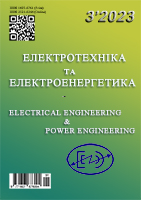Statistical analysis software
DOI:
https://doi.org/10.15588/1607-6761-2023-3-3Keywords:
statistical analysis, software, data processing, software review, IBM SPSS Statistics, RStudio, Stata, MinitabPython, Minitab, PythonAbstract
Purpose. Analysis of existing software to perform statistical analysis for further use as part of the selection of the necessary software for data processing.
Methodology. To conduct a software review, an analysis of scientific articles and open sources on statistical analysis software was conducted.
Findings. Choosing the right statistical software is a key decision in the field of data analysis, with numerous options to meet a variety of needs. This article provides a comprehensive overview of five leading statistical software tools: IBM SPSS Statistics, RStudio, Stata, Minitab, and Python. This paper reveals key insights into the capabilities, functions, and suitability of each tool for various analytical tasks.
This review concludes that the choice of statistical software should be consistent with specific project requirements, data complexity, and user experience. Researchers and analysts should consider their analytical goals and preferences when choosing the most appropriate tool. In addition, to make informed decisions in this dynamic field, it is important to stay abreast of new trends in data analysis and machine learning.
Originality. The conducted analysis revealed the possibilities and application of the most popular software for solving problems of statistical analysis. The work provides a comprehensive overview of current trends and innovations in the field of software for statistical analysis, offering readers a deeper understanding of existing tools.
Practical value. The conducted analysis will allow to choose software for solving a specific task of statistical analysis based on its characteristics and existing requirements. This work helps to identify the practical benefits of statistical analysis software and promotes the implementation of these tools in various fields of activity, providing improvements in analysis and decision-making processes.
References
Møltoft, J., (1987). Statistical analysis of data from electronic component lifetests (a tutorial paper). Active and Passive Elec. Comp., Vol. 12, pp. 259-279.
Górecki K., Kowalke W., (2022). Application of Statistical Methods to Analyze the Quality of Electronic Circuits Assembly. Applied Sciences, 12, 12694.
Elshahhat, A, Abu El Azm, WS. (2022). Statistical reliability analysis of electronic devices using generalized progressively hybrid censoring plan. Qual Reliab Eng Int., 38, 1112–1130. DOI: https://doi.org/10.1002/qre.3058
Xiaoqing, W., Nianping L., Wenjie Z. (2015). Statis-tical Analyses of Energy Consumption Data in Ur-ban Office Buildings of Changsha, Procedia Engi-neering, 121, 1158-1163, DOI: https://doi.org/10.1016/j.proeng.2015.09.125
Dudek G., Piotrowski P., Baczy´nski D. (2023). Intelligent Forecasting and Optimization in Electrical Power Systems: Advances in Models and Applications. Energies, 16, 3024. DOI: https://doi.org/10.3390/en16073024
Khwaja H. A., Gupta S. P., Kumar V. (2010). A Sta-tistical Approach for Fault Diagnosis in Electrical Machines, IETE Journal of Research, 56:3, 146-155, DOI: https://doi.org/10.4103/0377-2063.67099
Rychlik, Igor & Rydén, Jesper. (2006). Probability and risk analysis: An introduction for engineers, Springer Berlin, 291, DOI: https://doi.org/10.1007/978-3-540-39521-8.
Rofii F., Naba A., Dharmawan H.A., Hunaini F. (2020). Analysis of Electrical Power Quality Disturbances Based on Empirical Mode Decomposition and Statistical Parameters, IOP Conf. Series: Materials Science and Engineering, 846, 012050, DOI: https://doi.org/10.1088/1757-899X/846/1/012050
Abatan, S. M., Olayemi, M. S. (2014). The Role of Statistical Software in Data Analysis. Internation-al Journal of Applied Research and Studies, 3, 8, 1-15.
IBM SPSS Statistics [Еlectronic resource] – Access mode: https://www.ibm.com/products/spss-statistics.
RStudio IDE [Еlectronic resource] – Access mode: https://posit.co/products/open-source/rstudio/.
IBM SPSS Statistics [Еlectronic resource] – Access mode: https://uk.wikipedia.org/wiki/RStudio
Stata [Еlectronic resource] – Access mode: https://www.stata.com/.
Minitab [Еlectronic resource] – Access mode: https://www.minitab.com/en-us/
Rodriguez, D. Using Minitab to a.chieve Statistical Quality Control [Еlectronic resource] / D. Rodri-guez – Access mode: https://www.invensislearning.com/blog/statistical-quality-control-using-minitab/.
Python [Еlectronic resource] – Access mode: https://www.python.org/.
PyCharm [Еlectronic resource] – Access mode: https://www.jetbrains.com/pycharm/.
Downloads
Published
How to Cite
Issue
Section
License
Copyright (c) 2023 Valerii Dubrovin, Larysa Deineha, Anastasiya Yatsenko

This work is licensed under a Creative Commons Attribution-ShareAlike 4.0 International License.
Creative Commons Licensing Notifications in the Copyright Notices
Authors who publish with this journal agree to the following terms:
Authors retain copyright and grant the journal right of first publication with the work simultaneously licensed under aCreative Commons Attribution License that allows others to share the work with an acknowledgement of the work's authorship and initial publication in this journal.
Authors are able to enter into separate, additional contractual arrangements for the non-exclusive distribution of the journal's published version of the work (e.g., post it to an institutional repository or publish it in a book), with an acknowledgement of its initial publication in this journal.
Authors are permitted and encouraged to post their work online (e.g., in institutional repositories or on their website) prior to and during the submission process, as it can lead to productive exchanges, as well as earlier and greater citation of published work.

